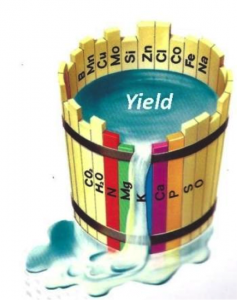The Law of Minimums
Aspiring hobbyists often fall prey to what might be called the ‘more is more’ fallacy. As we learn about how plants use nutrients to function and thrive, our natural inclination is to look to add to the system to improve results. This tendency is reinforced by bold manufacturer claims for products heralded as ‘best kept secrets’ and on forums assuring ‘explosive growth’ with this or that product. This is not to say that we don’t believe in the value of the various nutrients and additives we carry at Fifth Season Gardening; we do and can attest to each product’s various merits. However, before we consider adding extra inputs into our gardens or hydroponic systems, we consider Liebig’s Law.
Liebig’s Law, also known as The Law of Limiting Factors, derives from a discovery made by a German botanist named Carl Sprengel and later popularized by German chemist Justus Von Liebig. This law states that a plant’s performance is affected not by the most abundant resource, but by the most deficient one. Essentially, a plant will only yield as much as the least available nutrient allows. While this law ultimately had far reaching biological implications, this post focuses on the lessons germane to plant nutrients.
Liebig illustrated the concept of limitation using a metaphorical barrel with each stave representing a different element. A nutrient stave that was shorter than the others would cause the liquid contained in the barrel to spill out at that level. Illustrated otherwise, a cooper that built his barrel ten feet high would have worked in vain if his last stave was only five feet long. With this visual aid, the notion of limiting factors is intuitive and seems almost obvious, but is easily overlooked when attempting to remediate problems or improve yields.
Liebig’s Barrel
In order to illustrate ‘more is more fallacy’ further, consider the macronutrient phosphorus. Phosphorus (P) is crucial to a variety of plant functions: Beyond being an essential building block of ATP, the power producing molecules in mitochondria (the power generating organelles of plant and animal cells), phosphorus has been observed to enable seed production, promote root growth and early plant maturity amongst other things. But despite its botanical importance, phosphorus is often added excessively to compensate for poor plant performance; it is an essential macronutrient, but not a panacea. As described by Liebig’s Barrel, a plant can only metabolize a finite amount of P, in proportion to other nutrients, beyond which, it will have no effect, burn the plant, or runoff during irrigation. If you feel you are a victim of the ‘more is more’ fallacy, do not fret: this misunderstanding has been a major factor in excessive phosphorus and nitrogen running off into waterways and causing algae blooms. This process is known as eutrophication and results in oxygen deficient waters that starve fish.
To make matters worse, excessive amounts of certain nutrients can prohibit the uptake of other nutrients. Consider the barrel: with a finite supply of wood, if you make one stave too long, less wood remains to build other staves and further diminishes the ability of the barrel to hold liquid. Too much phosphorus can prohibit the uptake of iron; too much nitrogen can prohibit the uptake of calcium, etc. These similarly charged ions compete for space and displace others resulting in uptake suppression through the phloem vascular tissue.
The allure of dumping a pile of a product into a system hoping for a boost is real. But ultimately, one the most difficult skills for a grower to cultivate is correctly identifying the real ‘limiting factors’ of growth. This ability develops as a function of acquiring technical knowledge and paying close attention to the performance of plants before and after additions and treatments in your garden or farm. Adopting the paradigm of Liebig’s Law of the Limiting in your garden is an invaluable first step solving many cyclical problems and achieving your garden’s full horticultural potential.
By Sam Hanlin


taiwo says
This really helped. thanks
Dr. Axel W. says
It was not von Liebig who came up with the image of a barrel! Unfortunately, a common mistake. See original literature.
Mallikarjun Hebbal says
good explaination ,,
Somtui says
DR.AXEL IS RIGHT, Liebig didn’t come up with the metaphorical barrel. In fact he didn’t even discover the law of minimum. Carl Springel published the idea a decade earlier.